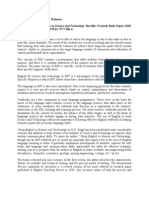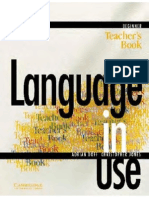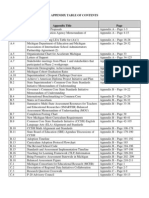Introduction Management English
Introduction Management English
Uploaded by
Echi KurniatiCopyright:
Available Formats
Introduction Management English
Introduction Management English
Uploaded by
Echi KurniatiOriginal Title
Copyright
Available Formats
Share this document
Did you find this document useful?
Is this content inappropriate?
Copyright:
Available Formats
Introduction Management English
Introduction Management English
Uploaded by
Echi KurniatiCopyright:
Available Formats
ESAP Management CB prelims:ESAP Business CB prelims 30/04/2009 15:28 Page 3
1 THE BUSINESS OF BUSINESS
Introduction
English for Management Studies is designed for students who plan to take a course in the field of
management entirely or partly in English. The principal aim of English for Management Studies is to teach
students to cope with input texts, i.e., listening and reading, in the discipline. However, students will be
expected to produce output texts in speech and writing throughout the course.
The syllabus focuses on key vocabulary for the discipline and on words and phrases commonly used in
academic English. It covers key facts and concepts from the discipline, thereby giving students a flying start
for when they meet the same points again in their faculty work. It also focuses on the skills that will
enable students to get the most out of lectures and written texts. Finally, it presents the skills required to
take part in seminars and tutorials and to produce essay assignments.
English for Management Studies comprises:
● student Course Book, including audio transcripts and wordlist
● the Teacher’s Book, which provides detailed guidance on each lesson, full answer keys, audio
transcripts and extra photocopiable resources
● audio CDs with lecture and seminar excerpts
English for Management Studies has 12 units, each of which is based on a different aspect of
management. Odd-numbered units are based on listening (lecture/seminar extracts). Even-numbered units
are based on reading.
Each unit is divided into four lessons:
Lesson 1: vocabulary for the discipline; vocabulary skills such as word-building, use of affixes, use of
synonyms for paraphrasing
Lesson 2: reading or listening text and skills development
Lesson 3: reading or listening skills extension. In addition, in later units, students are introduced to a
writing assignment which is further developed in Lesson 4; in later listening units, students are
introduced to a spoken language point (e.g., making an oral presentation at a seminar) which is
further developed in Lesson 4
Lesson 4: a parallel listening or reading text to that presented in Lesson 2 which students have to use their
new skills (Lesson 3) to decode; in addition, written or spoken work is further practised
The last two pages of each unit, Vocabulary bank and Skills bank, are a useful summary of the unit
content.
Each unit provides between 4 and 6 hours of classroom activity with the possibility of a further 2–4 hours
on the suggested extra activities. The course will be suitable, therefore, as the core component of a
faculty-specific pre-sessional or foundation course of between 50 and 80 hours.
It is assumed that prior to using this book students will already have completed a general EAP (English for
Academic Purposes) course such as Skills in English (Garnet Publishing, up to the end at least of Level 3),
and will have achieved an IELTS level of at least 5.
For a list of other titles in this series, see www.garneteducation.com/
You might also like
- English 101Document163 pagesEnglish 101Zainab Abbas0% (1)
- The Grammar Tree Second Edition TG 4 PDFDocument80 pagesThe Grammar Tree Second Edition TG 4 PDFFarya Shah100% (1)
- Book 19Document341 pagesBook 19johnharmu100% (1)
- 004 Expert Proficiency IntroDocument6 pages004 Expert Proficiency Introkimhoaihan_690223798No ratings yet
- Teaching English to Speakers of Other LanguagesFrom EverandTeaching English to Speakers of Other LanguagesRating: 3 out of 5 stars3/5 (1)
- Winter in VeniceDocument3 pagesWinter in VeniceBoca IrinaNo ratings yet
- Dictionaries and Language LearnersDocument211 pagesDictionaries and Language LearnersPhilippe HumbléNo ratings yet
- PE EL 3 PG 2 Hour 01-01-2013Document14 pagesPE EL 3 PG 2 Hour 01-01-2013Steve EdwardsNo ratings yet
- TA10 SGV EbookDocument224 pagesTA10 SGV EbookChu MỹNo ratings yet
- 20191B English 8 Course ProgramDocument8 pages20191B English 8 Course ProgramJuan Felipe NiñoNo ratings yet
- The Course Outline - English For APDocument4 pagesThe Course Outline - English For APAngelo NharNo ratings yet
- Teacher's Notes - 11 PDFDocument138 pagesTeacher's Notes - 11 PDFffhjkkNo ratings yet
- Leng 1157Document5 pagesLeng 1157Carlos CarantónNo ratings yet
- Cefr SOWDocument46 pagesCefr SOWEliyyahNo ratings yet
- Language For Study Level 3 Teacher's NotesDocument116 pagesLanguage For Study Level 3 Teacher's Notesธนะรุ่งศิริ วงศกร จุง100% (1)
- Using English in Science and TechnologyDocument3 pagesUsing English in Science and TechnologyRAM KRISHNA SINGH100% (3)
- Between PeoplesDocument4 pagesBetween Peoplesdjamila nadjiNo ratings yet
- Developing Academic Competency For Studies in English: The Malaysian ESL Teachers' PerspectiveDocument28 pagesDeveloping Academic Competency For Studies in English: The Malaysian ESL Teachers' PerspectiveSyafwan Ketemu IrawanNo ratings yet
- Starlight 10 Teacher's BookDocument112 pagesStarlight 10 Teacher's Bookполина ты ктоNo ratings yet
- Leng 1156: English 6 Course SyllabusDocument6 pagesLeng 1156: English 6 Course SyllabusNatalia BarrazaNo ratings yet
- Skills For Study 1 TBDocument118 pagesSkills For Study 1 TBang_pit6088No ratings yet
- Postgraduate Diploma in Teaching (PGDT) : Authors: Haregewoin FantahunDocument167 pagesPostgraduate Diploma in Teaching (PGDT) : Authors: Haregewoin FantahunShiferaw KibretNo ratings yet
- Karimi Soofloo ESP Session IVDocument6 pagesKarimi Soofloo ESP Session IVIELTS CouncilNo ratings yet
- Karimi Soofloo ESP Session IVDocument6 pagesKarimi Soofloo ESP Session IVIELTS CouncilNo ratings yet
- English For Academic Purposes (ESP) : ESP Session IV by Mehdi Karimi SooflooDocument6 pagesEnglish For Academic Purposes (ESP) : ESP Session IV by Mehdi Karimi SooflooIELTS CouncilNo ratings yet
- English For Secondary SchoolDocument170 pagesEnglish For Secondary SchoolashuzehabeshaNo ratings yet
- Classroom EnglishDocument168 pagesClassroom EnglishastatikeabebeNo ratings yet
- Achievers B1 Teacher S BookDocument371 pagesAchievers B1 Teacher S BookVioleta Martinez67% (3)
- Format and PresentationDocument23 pagesFormat and PresentationantarNo ratings yet
- Analysis of A School TextbookDocument2 pagesAnalysis of A School Textbookbss7wmnw5tNo ratings yet
- English. For PGDTDocument170 pagesEnglish. For PGDTmesfin yonasNo ratings yet
- 72 Teacher-S NotesDocument138 pages72 Teacher-S Notessaymon123456789No ratings yet
- Limba Engleza in AfaceriDocument139 pagesLimba Engleza in Afacerialexandru vespa100% (1)
- Academic English Autumn, 2018Document3 pagesAcademic English Autumn, 2018Zura PapiashviliNo ratings yet
- Morpho-Syntax IntroductionDocument5 pagesMorpho-Syntax IntroductionMelaniaNo ratings yet
- Teaching Approaches: Active GrammarDocument5 pagesTeaching Approaches: Active GrammarJose miguel Sanchez gutierrezNo ratings yet
- PDFDocument140 pagesPDFRamsha TjwNo ratings yet
- Third EditionDocument140 pagesThird EditionGulnaz AteeqNo ratings yet
- Course Program English 9B 04 Bimester1 2018Document5 pagesCourse Program English 9B 04 Bimester1 2018Juanita Vargas AvilaNo ratings yet
- Teacher BookDocument233 pagesTeacher BookRoman Tomashevskyi100% (2)
- Proficiency Cum Professional Development Course For Teachers of English From Colombia and EcuadorDocument2 pagesProficiency Cum Professional Development Course For Teachers of English From Colombia and EcuadorCynthia MirzapNo ratings yet
- Part I - Teaching Language MaterialsDocument56 pagesPart I - Teaching Language MaterialsNguyen TrucNo ratings yet
- Seminar Engleza BusinessDocument143 pagesSeminar Engleza BusinessBozdog Daniel100% (1)
- Libro 3,4,5 CompletoDocument82 pagesLibro 3,4,5 CompletoGonzalo GuarnizoNo ratings yet
- Yogendra Ko Book AnalysisDocument23 pagesYogendra Ko Book Analysischapagain_yNo ratings yet
- Primary Year 4 SK SOWDocument223 pagesPrimary Year 4 SK SOWSyafinaz SalvatoreNo ratings yet
- Considerations For Teaching An ESL or EFL Writing Course Report OutlineDocument12 pagesConsiderations For Teaching An ESL or EFL Writing Course Report OutlineCristian PaderesNo ratings yet
- Instructional Planning - Docx 0Document9 pagesInstructional Planning - Docx 0Justine MwendaNo ratings yet
- Achievers A2 Teacher S BookDocument397 pagesAchievers A2 Teacher S BookLlisa Antoño100% (3)
- ENGLISH - FOR - SPECIFIC - PURPOSES - Doc Filename - UTF-8 - 16. ENGLISH FOR SPECIFIC PURPOSESDocument5 pagesENGLISH - FOR - SPECIFIC - PURPOSES - Doc Filename - UTF-8 - 16. ENGLISH FOR SPECIFIC PURPOSESMarciano Ken Hermie100% (1)
- Teaching WritingDocument21 pagesTeaching WritingFatima ZahoorNo ratings yet
- Language Skills Development in The Efl ClassroomDocument191 pagesLanguage Skills Development in The Efl ClassroomDilbara KonurbaevaNo ratings yet
- 13 Nepali Basic Language TrainingDocument396 pages13 Nepali Basic Language TrainingSonam Gyatso100% (1)
- ELE1006 - ELE2006 - Limba Engleza in Afaceri PDFDocument139 pagesELE1006 - ELE2006 - Limba Engleza in Afaceri PDFIooAndreiRaresNo ratings yet
- Tefl Academy Unit-1 Part-2Document15 pagesTefl Academy Unit-1 Part-2Vinoth Kumar ChokkalingamNo ratings yet
- A The Aims of The CourseDocument8 pagesA The Aims of The CoursetonyplkNo ratings yet
- 202010A - Course Syllabus - 01Document8 pages202010A - Course Syllabus - 01Daniel Santamaria AlvarezNo ratings yet
- What Is EAPDocument9 pagesWhat Is EAPMoyano Martin 8 6 6 5 5 9No ratings yet
- Syllabus: Advance Speaking Skills Course Meeting Times Course ObjectivesDocument5 pagesSyllabus: Advance Speaking Skills Course Meeting Times Course Objectivesabegail libuitNo ratings yet
- Syllabus English Lang PrimaryDocument14 pagesSyllabus English Lang PrimaryDhinesh RajarathinamNo ratings yet
- 25 Dutch Reading Comprehensions for Beginners: Book One: Dutch Reading Comprehension TextsFrom Everand25 Dutch Reading Comprehensions for Beginners: Book One: Dutch Reading Comprehension TextsNo ratings yet
- How To Write Reading And Listening ActivitiesFrom EverandHow To Write Reading And Listening ActivitiesRating: 5 out of 5 stars5/5 (2)
- Makanjila Internal 2019Document370 pagesMakanjila Internal 2019Samuel EkpoNo ratings yet
- Experiment To Observe The Abundance and Variation of Plants Along An Interrupted Belt Transect and The Effect of Light IntensityDocument6 pagesExperiment To Observe The Abundance and Variation of Plants Along An Interrupted Belt Transect and The Effect of Light IntensityMiit PandolikerNo ratings yet
- UntitledDocument3 pagesUntitledRhylyn Khaye ReyesNo ratings yet
- Jihan Sherbini - 0Document99 pagesJihan Sherbini - 0Ind17 KhairunnisaNo ratings yet
- Book Review Lin & Martin Decolonization 2Document2 pagesBook Review Lin & Martin Decolonization 2Dikesh MaharjanNo ratings yet
- Self-Assessment Guide: Qualification Title: Food and Beverage ServiceDocument2 pagesSelf-Assessment Guide: Qualification Title: Food and Beverage ServiceMary Jane OcampoNo ratings yet
- Differences in Verbal and Performance IQ in Conduct Disorder Research Findings From A Greek SampleDocument5 pagesDifferences in Verbal and Performance IQ in Conduct Disorder Research Findings From A Greek SamplePaul HartingNo ratings yet
- Descriptive TextDocument23 pagesDescriptive TextIana CruzNo ratings yet
- HR Trends in 2018 - HRKathaDocument2 pagesHR Trends in 2018 - HRKathaNikita ZutshiNo ratings yet
- MID-YEAR REVIEW FORM (MRF) For Master Teacher I-IVDocument6 pagesMID-YEAR REVIEW FORM (MRF) For Master Teacher I-IVJufe Cali-at PartosaNo ratings yet
- Erik Erikson Psychosocial TheoryDocument1 pageErik Erikson Psychosocial Theorychinitangie100% (2)
- Professional Year Program BSBDIV301 - Working With Diversity Assessment Task 2.2 - Short Answer Questions & Case StudyDocument3 pagesProfessional Year Program BSBDIV301 - Working With Diversity Assessment Task 2.2 - Short Answer Questions & Case Studypun chin wai0% (1)
- Danjuma Abdulganiyu E.: CONTACT ADDRESS: 2, Saviour Street, Isashi, Off Badagry Expressway, LagosDocument2 pagesDanjuma Abdulganiyu E.: CONTACT ADDRESS: 2, Saviour Street, Isashi, Off Badagry Expressway, Lagosganiyu999No ratings yet
- Mi Final Rt3 Appendices With Budget 5.26.10Document617 pagesMi Final Rt3 Appendices With Budget 5.26.10flaminiom2927No ratings yet
- Automotive-Pecs Lo1-Activity-SheetsDocument6 pagesAutomotive-Pecs Lo1-Activity-SheetsJumar BaldrezNo ratings yet
- Call Center and Customer ServiceDocument2 pagesCall Center and Customer ServiceRayan SimonNo ratings yet
- 2.2 Types of Decision Making Biases 2.2.1 HeuristicDocument3 pages2.2 Types of Decision Making Biases 2.2.1 HeuristicAAditya Shaujan PaudelNo ratings yet
- Lesson Plan For Video LessonDocument4 pagesLesson Plan For Video LessonMia TaalNo ratings yet
- Study Plan 2024Document3 pagesStudy Plan 2024Zain Shahid100% (3)
- Language (50 Marks) 21 - 25 16 - 20 11 - 15 6 - 10 1 - 5: Revised Written Report Scoring RubricDocument3 pagesLanguage (50 Marks) 21 - 25 16 - 20 11 - 15 6 - 10 1 - 5: Revised Written Report Scoring Rubricsilent spritsNo ratings yet
- Leadership and Managment in NursingDocument157 pagesLeadership and Managment in Nursingamal abdulrahmanNo ratings yet
- Penerapan Man Resiko Unit Filing Rsud DR MoewardiDocument8 pagesPenerapan Man Resiko Unit Filing Rsud DR Moewardibina makmurNo ratings yet
- Language Experience ApproachDocument6 pagesLanguage Experience ApproachKristal Hope LaplanaNo ratings yet
- Result-Based Performance Management System (RPMS) : PortfolioDocument19 pagesResult-Based Performance Management System (RPMS) : PortfolioSonia AgustinNo ratings yet
- SEQUENCE 3 LinguestiueDocument3 pagesSEQUENCE 3 Linguestiueabrous.sonia93No ratings yet
- Final Exam PaperDocument7 pagesFinal Exam PaperPatel HarryNo ratings yet
- SHS Faculty Readiness and Availability of Facilities: Its Effect To The Teaching and Learning ProcessDocument10 pagesSHS Faculty Readiness and Availability of Facilities: Its Effect To The Teaching and Learning ProcessJr RequitaNo ratings yet
- Demonstrative Pronouns Lesson PlanDocument14 pagesDemonstrative Pronouns Lesson PlanTino Andres Pinilla Machado100% (1)

























































































